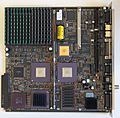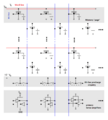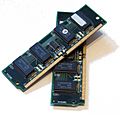Dynamic random-access memory facts for kids
Dynamic random access memory is the most commonly used form of RAM.
DRAM is called dynamic (or active), because it must be refreshed all the time or it will lose the data which it is supposed to be storing. Because it loses data when power is removed, DRAM is called volatile. This word comes from the Latin adjective volātilis, which means "flying, fleeting, transitory".
Refreshing DRAM means reading the data from the DRAM and directly writing them back to the DRAM. DRAM is made up of millions of very small capacitors. Each of these capacitors has a transistor to let energy in and out. The capacitor slowly loses energy, and if the DRAM is not refreshed, in the end one or more of the capacitors will let so much energy out, that for example a 1 will become a 0, so data will be lost or corrupted. Almost all computers refresh their DRAM many times per second.
Comparison DRAM and SRAM
DRAM is often compared to SRAM (Static RAM). SRAM is able to store data as long as power/energy is used. There is no need to refresh it. SRAM can also be faster than DRAM. But SRAM is much more expensive than DRAM. Also, SRAM uses more electric power and heats up much faster than DRAM. DRAM and SRAM lose the data when the power to them is turned off, unlike non-volatile random-access memory.
Images for kids
-
A die photograph of the Micron Technology MT4C1024 DRAM integrated circuit (1994). It has a capacity of 1 megabit equivalent of 2^{20}bits or 128 kB.
-
A pair of 32 MB EDO DRAM modules
-
1 Mbit high speed CMOS pseudo static RAM, made by Toshiba
See also
 In Spanish: DRAM para niños
In Spanish: DRAM para niños












